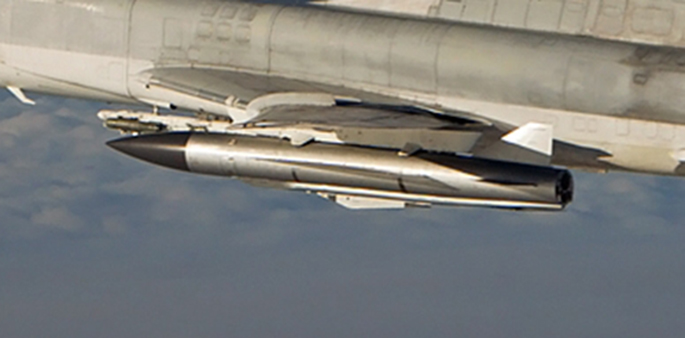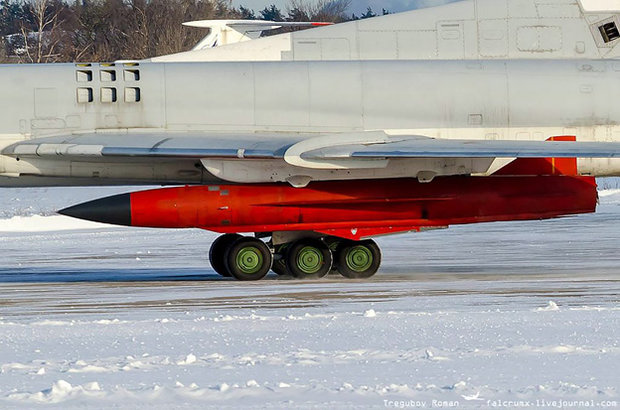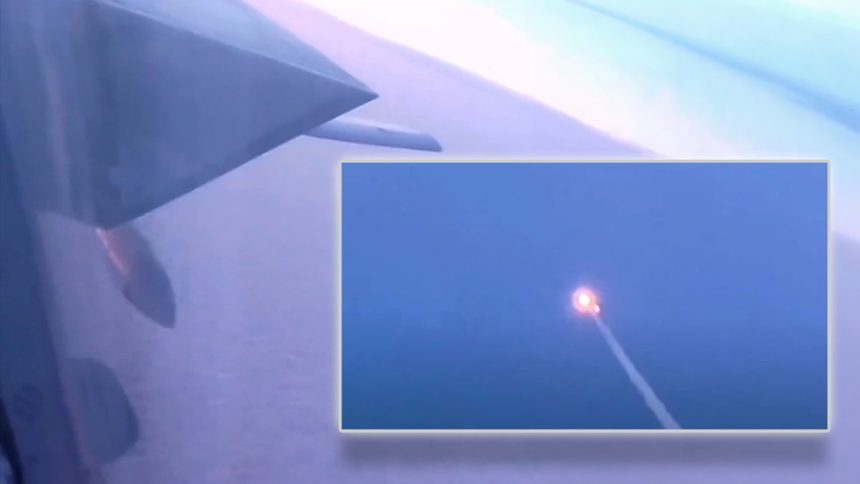The footage shows, from a Tu-22M3 aircraft, the release of a Kh-32 ALCM during an air strike on Ukraine.
An interesting clip was shared online by the Fighterbomber Telegram channel on May 11, 2024. The footage, undated, shows the release of a Kh-32M cruise missile from a Tu-22M3, reportedly, during an air strike on Ukraine.
Several stills from the video below that show the release of a Kh-32(M) air-to-surface missile from a VKS Tu-22M3.
Per the Fighterbomber Telegram channel, which uploaded the undated footage earlier today, the two missiles seen in the video were launched against Ukraine. https://t.co/0ge6hU09IN pic.twitter.com/fbyJzOYJ3s
— Guy Plopsky (@GuyPlopsky) May 11, 2024
Kh-32 and Kh-22
The Kh-32 is a supersonic air-launched cruise missile developed by Russia and designed, primarily, for anti-ship and anti-radiation strike missions: the missile is in fact capable of engaging both naval surface targets and land-based radars.
It is an upgrade to the Kh-22 (NATO reporting name AS-4 “Kitchen”) a long-range, anti-ship missile designed primarily for use against naval surface targets, developed during the Cold War.
The Kh-22 has a range of approximately 600-700 kilometers (370-435 miles) and can carry a large conventional or nuclear warhead, depending on the variant.

For comparison, here are some key features and characteristics of the Kh-32 missile, officially adopted at the end of 2016:
- Supersonic Speed: The Kh-32 is a high-speed missile, capable of reaching speeds of up to Mach 5 (approximately 6,200 km/h or 3,900 mph). This makes it difficult for enemy defenses to intercept.
- Long range: The missile has a long operational range, reported to be over 1,000 kilometers (620 miles). This enables it to engage targets from significant distance, well beyond the reach of the enemy air defense systems.
- Warhead flexibility: The Kh-32 can be equipped with different types of warheads depending on the mission requirements. It can carry a conventional high-explosive warhead for anti-ship missions or specialized anti-radiation warheads to target enemy radar installations.
- Precision Guidance: The missile uses an onboard guidance system for accurate navigation towards its target. This guidance system may include inertial navigation, satellite navigation (such as GLONASS), and potentially terminal active radar homing for improved accuracy.
- Anti-Ship Capabilities: With its high speed, long range, and anti-ship warhead options, the Kh-32 is effective against a variety of naval targets, including surface combatants and aircraft carriers.
- Anti-Radiation Capabilities: In its anti-radiation configuration, the Kh-32 can home in on and destroy enemy radar installations, providing a valuable capability for suppressing air defenses, compared to other shorter range weapons, that would force the missile carrier to fly closer to the target, potentially within the range of the enemy SAMs (Surface to Air Missiles)
- While the Kh-22 could be carried by the Tu-22M3 Backfire, the Tu-22 Blinder and the Tu-95 Bear, the Kh-32 can only be carried by the Tu-22M3.

Operational use in Ukraine
The first operational use of these missiles was observed during the 2022 Russian invasion of Ukraine. On May 11, 2022, a video surfaced online showing a Russian Air Force Tu-22M3 strategic bomber launching two Kh-22 or Kh-32 missiles at targets within Ukraine.
The UK Ministry of Defence expressed concern that Russia might be employing anti-ship missiles like the Kh-22 against ground targets, cautioning that such missiles are not highly accurate and could cause significant collateral damage and casualties.
Subsequent reports detailed multiple instances of Russian Air Force strikes using Kh-22 missiles. For example, on May 9, 2022, 13 Kh-22 missiles were reportedly launched, with several directed at Fontanka, resulting in casualties, and others targeting locations in Donetsk Oblast. Between May 12 and June 25, 2022, additional Kh-22 strikes were reported, totalling at least 44 missiles used.
The wreckage of a Kh-22 missile in Odesa.https://t.co/Kr46xJIu3Ahttps://t.co/Nqy7ZuoGyK pic.twitter.com/INQswWxoiK
— Rob Lee (@RALee85) May 31, 2022
A notable incident occurred on June 27, 2022, when two Kh-22 or Kh-32 missiles, launched by Russian Tupolev Tu-22M3 bombers, struck a shopping mall in Kremenchuk, resulting in significant casualties. Another attack on June 30, 2022, involving three Kh-22 missiles, caused further destruction and casualties in Serhiivka.
In September 2022, reports indicated that Russia employed Kh-22 missiles in strikes on hydraulic structures in Kryvyi Rih, altering river water levels significantly.
The Ukrainian Air Force claims 11 Shahed-131/136/ Geran-2 were shot down, and that Russia launched up to 6 Kh-22 and Kh-32 missiles from Tu-22M3 bombers and two Kh-31P missiles. The Tu-95Ms bombers launched from Rostov Oblast and the Caspian Sea. 2/https://t.co/SyfUzwC1RL pic.twitter.com/Hojmmp9dqw
— Rob Lee (@RALee85) December 29, 2022
Further attacks in January 2023 and May 2023 resulted in civilian casualties and damage to infrastructure.
For example, the Ukrainian Air Force says it shot down a large number of the shahed drones and air-launched cruise missiles launched on Dec 29, but none of the 8 Kh-22/Kh-32; 14 S-300/S-400/Iskander-M, or 5 Kinzhal missiles were intercepted.https://t.co/Opra9KVmKu
— Rob Lee (@RALee85) January 4, 2024
Ukraine claimed its first successful interception of a Kh-32 missile in April 2024 and the downing of a Tu-22M3 demonstrating the ongoing use of these weapons in the conflict and the evolving capabilities of Ukrainian defenses.
Ukraine’s air defense has made history by intercepting a state-of-the-art Russian Kh-32 cruise missile produced in 2023 🇺🇦
The Kh-32 (modified Kh-22, range 600-1000 km & speed up to Mach 4.6) was likely shot down on 19 April along with a Tu-22M3 bomber https://t.co/QgOtRFrUZY pic.twitter.com/ny8rfmTizX
— Euromaidan Press (@EuromaidanPress) April 20, 2024









